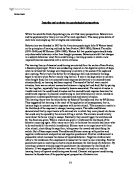In the Second Phase of the experiment, known as The Acquisition Stage, the meat powder (UCS) was paired with the sound of a tone (CS). First the tone was sounded then the meat powder was delivered. For the experiment to succeed the CS must precede the UCS. This pairing of stimuli was repeated several times – tone then food, tone then food and so on.
In the Third phase, to test if the dog had learned to associate the tone with the food the dog was exposed to the tone without the presentation of food. On hearing the tone the dog began to salivate. Pavlov had achieved a conditioned response CR. The dog had been taught, conditioned, to associate the tone with the food, and it’s conditioned response was to salivate. Pavlov’s experiment was the first demonstration of what is called CLASSICAL CONDITIONING. The experiment is diagrammed below in
Fig.(a)
Fig.(a) CLASSICAL CONDITIONING
Phase 1. Before conditioning has occurred.
UCS (Unconditioned Stimulus) → UCR (Unconditioned Response)
e.g. Meat Powder results in i.e. Salivation.
Neutral Stimulus → Orienting Response
e.g. A tone, bell or white coat results in i.e. Barking Picking up ears (but no salivation)
Phase 2. The process of conditioning.
Neutral Stimulus followed UCS → UCR
(must be presented first + Meat powder results in Salivation
or the experiment by
won’t work)
Phase 3. After conditioning has occurred.
CS (Conditioned Stimulus) → CR (Conditioned Response)
i.e.Tone, bell or white coat results in Salivation
Many human responses are also classically conditioned. For instance, chemotherapy in cancer patients (the injection of toxins into the body to prevent growth of tumors) often results in terrible nausea. It is not uncommon for patients to feel nauseous at the mere sight of the treatment room. The repeated pairing of the sight of the treatment room, the CS, with the chemotherapy, the UCS, leads the patient to associate the treatment room with the chemotherapy and causes the patient to feel nauseous, the CR, before treatment even begins.
Pavlov noticed that the more frequently the CS was paired with the UCS in the Acquisition stage of the process, the more often a CR was elicited. During this stage, repeated pairings of the CS with the UCS are said to reinforce the association between the two. This is illustrated in figure (b) below.
Figure (b)
If this association is not reinforced, i.e. the UCS (meat powder) is omitted repeatedly, the response will gradually diminish: this is called Extinction. (illustrated in Figure (c) below.
Figure (c )
As the trials proceed, the dog is repeatedly allowed to hear the tone without receiving food it gradually stops salivating at the sound of the tone alone. It learns that the tone (CS) is no longer a signal for food and extinction occurs.
A conditioned response that has been extinguished can however be resurrected. One way is by repeating the acquisition stage of the experiment. This reconditioning usually requires fewer trials for the CR to return to its former strength than in the initial conditioning process, suggesting that the CR was not completely extinguished but merely somehow masked. The fact that the CR can be masked over a period of reinforcement being withdrawn and then resurrected once the reinforcement is reintroduced shows the existence of the phenomenon which Pavlov called Spontaneous Recovery.
So far all my examples of UCS have been biologically significant, i.e. food, chemotherapy etc. However it is possible for another stimulus to gain the power of a UCS by being consistently paired with a biologically significant UCS. Suppose for a cancer patient the treatment room has become conditioned to the chemotherapy (a biologically significant experience). If you then repeatedly present the patient with a neutral stimulus (e.g. a tone) followed by a picture of the treatment room, they may begin to experience some unpleasant feeling on hearing the tone. This phenomenon is called Second-Order Conditioning. The treatment room, which served as the CS in first-order conditioning now functions as a UCS for a second-order conditioned response. In effect the tone became a signal for the treatment room, which previously had signaled the delivery of the chemotherapy treatment.
Source - A Science Odyssey : People and Discoveries www.pbs.org
Source – Douglas A. Bernstein Et. Al. Psychology Third Edition. Houghton 1994.
Source – Hilgard’s Introduction to Psychology. Twelfth Edition.







